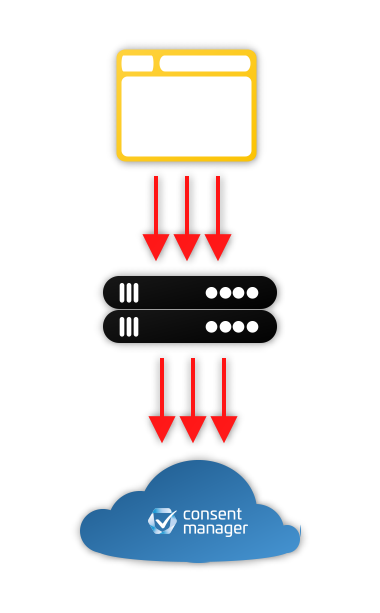Working with whitelabeld domains
This feature is not included in all packages. Please consult your account manager in order to find out if this feature is possible in your package.
Please note that we currently only allow one whitelabel per account.
The whitelabel domain feature allowes you to serve the CMP-codes via your own domain instead of the consentmanager domain. This can increase the performance and decrease issues (e.g. with adblockers).
General setup
The general setup is as follows:
- Instead of directing the traffic to consentmanager, the browser will call your whitelabel domain. The domain will point at a (reverse) proxy service such as CloudFront, Akamai or CloudFlare.
- The proxy will forward the request to the consentmanager servers.
- The consentmanager servers will respond.
- The proxy forwards the request to the browser.
Proxy structure
In order to deliver content via your own domain you will need to setup 2 or 3 proxies depending on the use-case:
- One proxy will be dedicated to serve dynamic content. This includes the consent information and all content that is user specific, as well as all calls to counting and protocol mechanisms.
- One proxy will be dedicated to serve static content. This includes images, javascript files and css. Usually a CDN is used for this.
- (optional) One proxy will be dedicated to serve the configuration interface (login area) for the customers.
Proxy requirements
All proxies need to match the following requirements:
- The proxy must support HTTP/HTTPS 1.2
- The proxy must respond with a valid SSL certificate for the domain. SSL certificates should have a 4KB encryption key and an A-rating on ssllabs.com for best compability.
- The requesting IP-Address needs to be forwarded using X-forwarded-for HTTP Header
- The source host (our domain) needs to be sent via host HTTP header (e.g. Host: cdn.consentmanager.net)
- The requesting host (your domain) needs to be forwarded using X-forwarded-host HTTP Header (e.g. X-forwarded-host: static.yourdomain.com)
- The requesting cookies need to be forwarded. Responding cookies need to be forwarded.
- The proxy may not cache any request, except when HTTP headers indicate. If caching is allowed, the maximum cache duration must not exceed 60 minutes.
- The proxy may not perform any row level logging (e.g. storing IP-adresses, browser information and such)
- The proxy must not ignore query strings when caching is allowed. It should treat two URLs with different query strings as separate URLs and fetch separate requests from the endpoint.
- The proxy must support CORS origin headers.
System setup
In order to setup your proxies please send us the three domains (usually something like static.yourdomain.com, dynamic.yourdomain.com, config.yourdomain.com). In return you will receive 3 endpoint URLs from us to be set as a target for your proxies. Please ensure that each proxy works and let us know once the setup is finished on your end. We will perform some additional checks and then enable the domains for your account.









